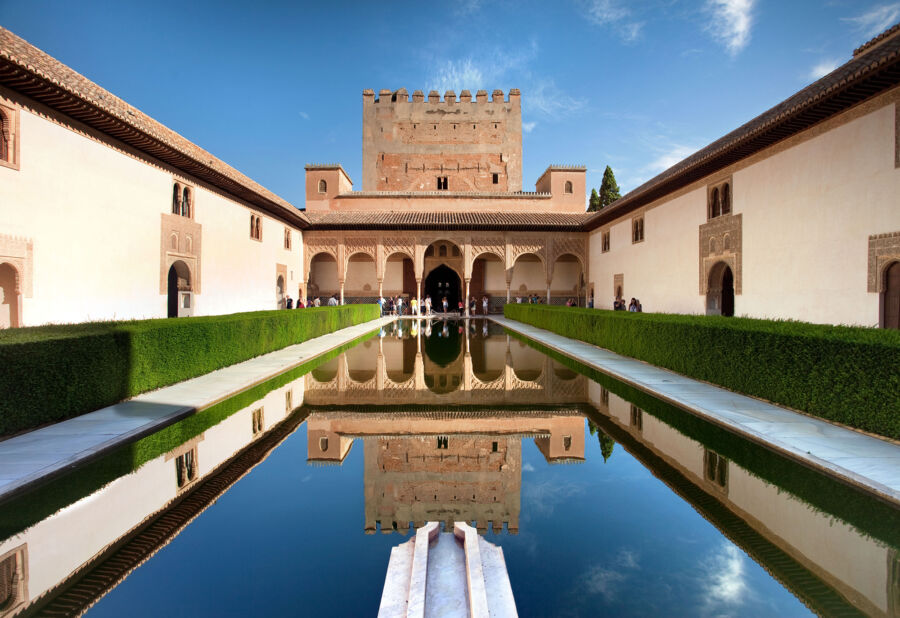
For me, one of many nice joys of journey is having in-person encounters with nice artwork and structure — which I’ve collected in a e book referred to as Europe’s High 100 Masterpieces. Right here’s one in every of my favorites:
Nowhere else does the splendor of Moorish civilization shine so superbly than on the Alhambra — this final and best Moorish palace in Europe.
For seven centuries (711–1492), a lot of Spain was Muslim, dominated by the Islamic Moors from North Africa. Whereas the remainder of Europe was slumbering via the Darkish Ages, Spain blossomed below Moorish rule. The end result was the Alhambra — a sprawling advanced of palaces and gardens atop a hill in Granada. And the spotlight is the beautiful Palacios Nazaríes, the place the sultans and their households lived, labored, and held courtroom.
You enter via the aromatic Courtroom of the Myrtles, right into a world of ornately embellished rooms, stucco “stalactites,” filigreed home windows, and effervescent fountains. Water — so uncommon and treasured within the Islamic world — was the purest image of life. The Alhambra is embellished with water, water in every single place: standing nonetheless, cascading, masking secret conversations, and drip-dropping playfully.
As you discover the labyrinth of rooms, you possibly can simply think about sultans smoking hookahs, lounging on pillows and Persian carpets, with heavy curtains on the home windows and incense burning from the lamps. Partitions and ceilings are lined with intricate patterns carved in wooden and stucco. (If the Alhambra’s interweaving patterns look Escheresque, you’ve bought it backward: The artist M. C. Escher was impressed by the Alhambra.) As a result of Muslim artists prevented making pictures of residing creatures, they ornamented with calligraphy — by carving swoopy letters in Arabic, quoting poetry and verses from the Quran. One phrase — “solely Allah is victorious” — is repeated 9,000 instances.
The Generalife gardens — with manicured hedges, reflecting swimming pools, playful fountains, and a breezy summer season palace — is the place sultans took a break from palace life. Its architect, in a means, was the Quran, which says that heaven is sort of a lush oasis, and that “those that consider and do good, will enter gardens via which rivers stream” (Quran 22.23).
The Alhambra’s much-photographed Courtyard of the Lions is called for its fountain of 12 marble lions. 4 channels carry water outward — figuratively to the corners of the earth and actually to the sultan’s personal flats. As a poem carved onto the Alhambra wall says, the fountain gushes “crystal-clear water” like “the complete moon pouring gentle from an unclouded sky.”
The palace’s largest room is the ornate throne room — the Grand Corridor of the Ambassadors. Right here the sultan, seated on his throne beneath a domed ceiling of stars, obtained guests. The ceiling, constituted of 8,017 inlaid items of wooden (like a large jigsaw puzzle), suggests the complexity of Allah’s infinite universe.
The throne room represents the passing of the torch in Spanish historical past. It was right here within the yr 1492 that the final Moorish king surrendered to the Christians. And it was right here that the brand new monarchs, Ferdinand and Isabella, stated “Sí, señor” to Christopher Columbus, launching his voyage to the New World that might make Spain wealthy. However the glory of the Alhambra lived on, including an class and charm to Spanish artwork for hundreds of years to return.
At the moment, the Alhambra stands as a thought-provoking reminder of a sleek Moorish world which may have flowered all through all of Europe — however didn’t.



